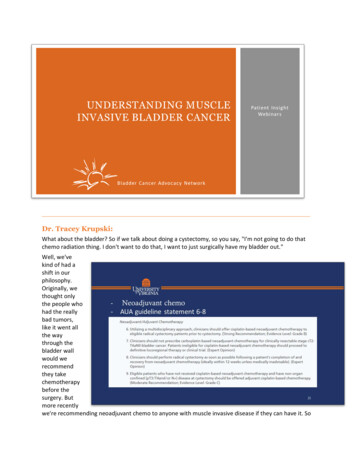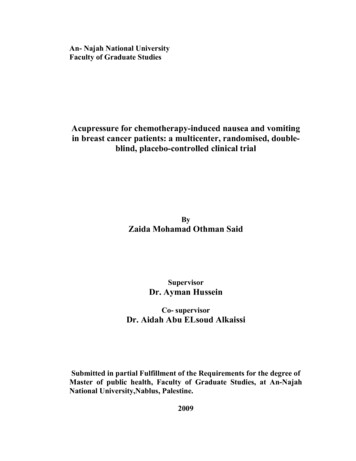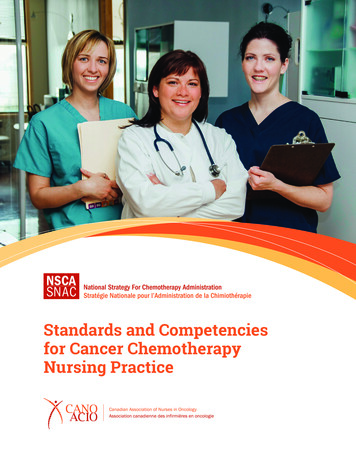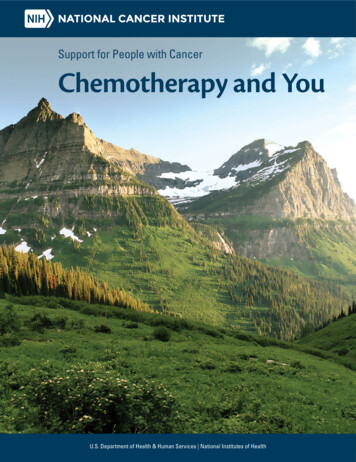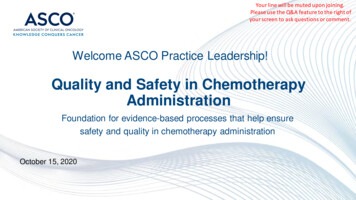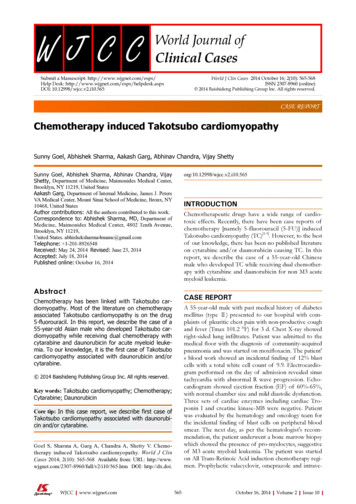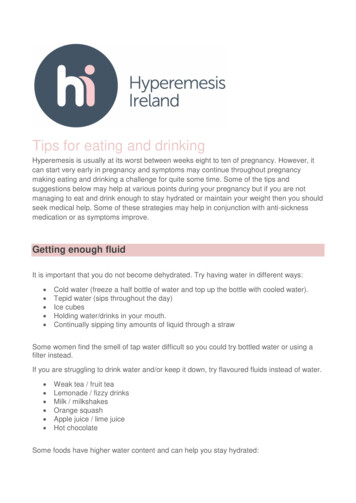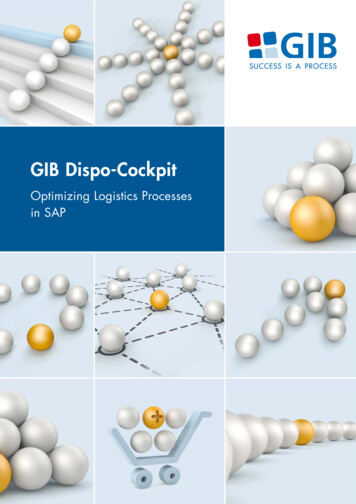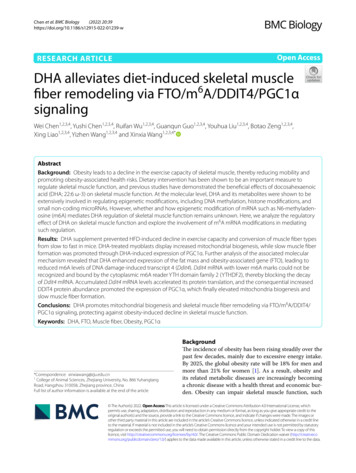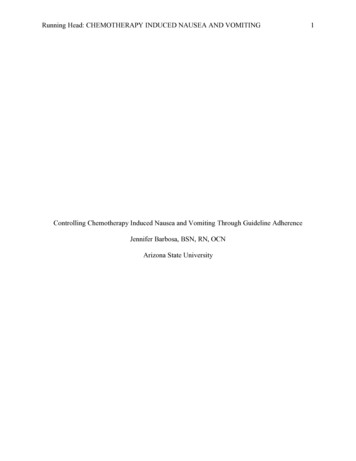
Transcription
Running Head: CHEMOTHERAPY INDUCED NAUSEA AND VOMITINGControlling Chemotherapy Induced Nausea and Vomiting Through Guideline AdherenceJennifer Barbosa, BSN, RN, OCNArizona State University1
CHEMOTHERAPY INDUCED NAUSEA AND VOMITING2AbstractBackgroundThirty to fifty percent of cancer patients undergoing chemotherapy will experiencechemotherapy induced nausea and or vomiting (CINV) despite the use of antiemetic prophylaxisUncontrollable CINV can lead to complications that add extra stress to patients, increase inhealthcare costs, and utilization of resources. CINV can lead to chemotherapy dose reductions,treatment delays, chemotherapy changes, or discontinuation of treatment. Guidelines exist tobetter prevent and treat CINV. Evidence supports the use of guidelines to prevent CINV,however patients still suffer from CINV often due to a lack of guideline adherence.ObjectivesThe purpose of this project was to increase CINV guideline adherence by increasingknowledge of antiemetic guidelines utilizing an educational intervention for providers and nursesat an outpatient oncology office.MethodsA brief educational intervention on CINV and recommended NCCN guidelines wasconducted with providers and nurse (n 6) at an oncology practice in Southwestern United States.An evaluation to assess change in knowledge was performed using a pre and post test format.Statistical analysis was performed using descriptive statistics, McNemar tests and WicoxanSigned Rank Test.FindingsThere was a significant effect on knowledge of NCCN antiemetic guidelines (Z -1.89,p 0.059, mean 2.5) post intervention. There also was a significant impact on likelihood to useguidelines in practice (Z -1.89, p 0.059, mean 2.5). Increasing awareness and likelihood to
CHEMOTHERAPY INDUCED NAUSEA AND VOMITINGfollow recommended guidelines may improve CINV symptoms in patients undergoingchemotherapy and improve the treatment outcomes for these patients.Keywords: CINV, Chemotherapy, Symptoms management, guideline adherence3
CHEMOTHERAPY INDUCED NAUSEA AND VOMITING4Chemotherapy Induced Nausea and Vomiting Guideline AdherenceOne of the most distressing side effects of cancer treatment is chemotherapy inducednausea and vomiting (CINV). CINV is difficult to assess and treat because it is subjective andoften underreported by patients and its impact is often under estimated by providers.Problem StatementChemotherapy induced nausea and vomiting adds extra stress to patients and causes anincrease in healthcare costs and utilization of resources. CINV can lead to chemotherapy dosereductions, treatment delays, chemotherapy changes, or discontinuation of treatment. Van Lear,Desai, and Jatoi (2015) found 32% of oncologists surveyed needed to delay or dose reducechemotherapy due to CINV. Guidelines exist to better prevent and treat CINV (AmericanSociety of Clinical Oncology [ASCO], 2017; National Comprehensive Cancer Network[NCCN], 2017). Evidence supports the use of guidelines to prevent CINV, however patients stillsuffer CINV often due to a lack of guideline adherence (Caracuel, Munoz, Banos, & Ramirez,2015).Purpose and RationaleChemotherapy induced nausea and vomiting is one of the most distressing and severeside effects of chemotherapy for patients (Hernandez Torrez et al., 2015; Inoue et al., 2015).Uncontrolled CINV negatively impacts patients’ lives and can lead to decreased quality of life,dehydration, and poor treatment outcomes. There is an extensive body of evidence to guideproviders in effectively preventing and managing CINV. The purpose of this project is to createmore knowledge and awareness of these guidelines in an effort to increase their use in practice.Background and Significance
CHEMOTHERAPY INDUCED NAUSEA AND VOMITING5The National Cancer Institute (NCI) (2016) estimates one million people are diagnosedwith cancer each year and for many of these people chemotherapy is a treatment option. It isestimated 30-50% of patients undergoing chemotherapy experience CINV (Hu et al., 2016;Moradian & Howell, 2015). It is a major concern because if left uncontrolled it can lead to dosereductions, treatment delays, and unanticipated stoppage of treatments which can affect overalltreatment outcomes. Improving treatment outcomes and improving supportive and palliativetherapy are major initiatives of the NCI (National Cancer Institute [NCI], 2016).CINV is a major area of concern for both patients and providers. Hernandez Torres et al.(2015) suggest many providers consider adequate treatment of CINV to be the absence ofemesis. However, patients report nausea just as distressing as vomiting (Hernandez Torres et al.,2015; Vidall et al., 2015). Patients have also suggested providers underestimated the impactnausea has on daily life (Vidall et al., 2015). Van Lear et al. (2015) found 88%-92% of providersfelt they could adequately control CINV but 38% of providers admitted to delaying, stopping, orchanging chemotherapy due to uncontrolled CINV. This gap in patient provider perception of theimpact of CINV suggests room for improvement in understanding and managing symptoms.Treating CINV can be a difficult undertaking as there are many risk factors and multiplemechanisms of actions. CINV usually occurs in the first 5 days following chemotherapyadministration and poorly controlled nausea and vomiting during this time can cause anticipatorynausea and vomiting in following cycles of chemotherapy (Hopkins &Donovan, 2014; NCCN,2017; Tegeja &Groning, 2016).Another complexity in the management of CINV is the emetogenic potential of certainchemotherapies meaning the likelihood of a chemotherapy to cause nausea and vomiting.Different chemotherapies and regimens have different emetogenic potentials which creates the
CHEMOTHERAPY INDUCED NAUSEA AND VOMITING6need for varying medications to control CINV. Tageja and Groninger (2016) as well as Boccia(2013) indicate multiday regimens for IV chemotherapy and oral chemotherapy agents furtheradd to the emetogenic potential of medications.The different types of CINV, multiple mechanisms of action, individual risk factors andthe different emetogenic potential of chemotherapeutic agents require a complex assessment andmultipronged approach to successfully manage CINV. This complexity has led to the importanceof guidelines for the management CINV.To help manage the effects of CINV, professional organizations have created guidelinesto help providers to adequately prescribe the correct prophylaxis and treatment needed. Threemain organizations – the Multinational Association for Supportive Care in Cancer/ EuropeanSociety for Medical Oncology (MASCC/ESMO), ASCO, and NCCN have all issued guidelinesfor the management of CINV. These guidelines were based on research and evidence inantiemetic agents, as well as consensus of experts. The Oncology Nursing Society (ONS), themajor certifying agency for chemotherapy administration, recommends the utilization ofguidelines.Despite the evidence and consensus behind the guidelines, there is a lack of adherence toguideline recommendations. Guideline adherence is the responsibility of providers and patients.Providers must be aware of guideline recommendations to prescribe and educate the patients.Gilmore et al. (2014) found patients were less likely to experience CINV when guidelines werefollowed.Guideline nonadherence can take many shapes and forms such as prescribing incorrectclasses of medications, not prescribing corticosteroids in the delayed phase, and the over dosingof some medications. All of the guidelines take into account the emetogenic potential of the
CHEMOTHERAPY INDUCED NAUSEA AND VOMITING7chemotherapy agents used. The emetogenic potential of chemotherapy agents are classified ashighly emetogenic (HEC), moderately emetogenic (MEC), low emetogenic (LEC), andminimally emetogenic. Some providers are less likely to adhere to guidelines with LEC, mostlyby over prescribing medications with LEC regimens (Franca et al., 2015; Vidall et al., 2015).Other studies have found that guideline nonadherence was due to the lack of prescribingcorticosteroids during the delayed phase of CINV (Burmeister, Aebi, Studer, Fey, & Gautschi,(2012).Another aspect of guideline adherence is patient compliance with medications. Patientsmust comply with the guideline recommendations and take medications as prescribed to achieveoptimal results. Patient compliance is easier to manage in the hospital setting as nurses are oftenadministering medications, however this is difficult to control in the outpatient setting when thepatient must take medications independently at home in the days following chemotherapyadministration. Caracuel et al. (2015) found only 61% of patients were compliant with their oralantiemetics. In another survey, only 38% of patients remembered taking their antiemetics asinstructed (Vidall et al., 2015). Reasons patients did not want to take medications included notwanting to taking medications when not feeling nauseous, not wanting to take any additionalmedications, and being afraid taking medications may lead to vomiting (Vidall et al., 2015).Educating both providers and patients may be a way to help improve guideline adherence andbetter control CINV.In an oncology practice in the Southwestern United States, patients are usually given theirchemotherapy education on a day prior to starting chemotherapy. On this day, the patient oftenreceives all the information needed for their entire chemotherapy course, including informationfor managing CINV. This amount of information is overwhelming and often forgotten. There is
CHEMOTHERAPY INDUCED NAUSEA AND VOMITING8no system currently set up to track the incidence of CINV or dehydration related to CINV in thispractice.Providers will often follow some of the NCCN guideline recommendations to insureinsurance approval; however, there are often inappropriate exceptions or omissions. Forexample, patients receiving HEC will often be written for a prescription for an NK-1 receptorantagonist (NK-1RA), 5-HT3RA, and corticosteroids per NCCN guidelines. Some patients arenot able to afford the high cost associated with the NK-1RA and often this gets removed fromthe treatment plan. NCCN also recommends the use of olanzapine, an atypical antipsychotic, andcorticosteroids orally as antiemetic prophylaxis prior to HEC but this option is rarely utilized.The severity of CINV experienced by patients and the lack of guideline adherence raisethe following PICO question: In adults undergoing chemotherapy, how does guideline adherencecompare to nonadherence affect CINV?Search ProcessA search of the literature was done using 3 databases - CINHAL, PubMed, and theCochrane library. Search terms included chemotherapy, antiemesis, nausea, vomiting, guidelines,protocols, adherence, and compliance. Variations of these terms were also searched. The resultswere limited to the last 5 years to make sure current evidence was being used. All of the studiesconsidered needed to include the use of chemotherapy guidelines. The results were also limitedto adults over the age of 18. Ancestry was also used during the literature search (Appendix A).Critical Appraisal and SynthesisFollowing the literature search, 10 high quality studies were used for critical appraisaland analysis. Most of the studies were level three cohort studies but two of the studies were level2 randomized control trials (RCTs) according to the hierarchy of evidence (Melnyk &Fineout-
CHEMOTHERAPY INDUCED NAUSEA AND VOMITING9Overholt, 2015). The eight other studies reviewed were observational studies, retrospective andprospective studies (Appendix B). There was homogeneity as all the studies showed betterCINV outcomes with guideline adherence as a result, but only one study looked at patientadherence to prescription medication (Caracuel, et al., 2015). The samples all included cancerpatients undergoing chemotherapy. Three studies looked at breast cancer patients and one studylooked at glioma patients. There was some heterogeneity in the guidelines. Some studies used acombination of guidelines and some used independent institutional protocols.The studies took place all over the world, Europe, Japan, Singapore, Canada, and theUnited States. Most of the studies followed international guidelines except for two studies whichfollowed institutional guidelines. The most common guideline used was MASCC/ESMOguideline (Appendix C).The consensus of results from the critical analysis shows guideline adherence whenprescribing antiemetics has better outcomes. Antiemetic guidelines are evidenced based and havebeen shown to decrease CINV incidence. Decreased incidence of CINV improves the overalltreatment experience and treatment outcomes of patients. Improving guideline adherence in bothpatients and providers can reduce the overall incidence of CINV. Controlling CINV in earlychemotherapy cycles also improves the rates of anticipatory CINV in following cycles.Guideline consistent prescribing leads to less office and emergency room visits for dehydrationsecondary to CINV, lowering health care costs. Ensuring guideline adherence can reduce healthcare costs and decrease the incidences of CINV.Conceptual/Theoretical Model and Evidence Based Practice ModelThe theory of symptom management depicts the three main components, symptomexperience, the components of symptoms management, and the outcome, as being interrelated
CHEMOTHERAPY INDUCED NAUSEA AND VOMITING10and affecting each other (Linder, 2010). The symptoms experience and symptom managementstrategies are encompassed in the outcomes (Appendix D). The symptom experience, CINV,includes the perception, evaluation, and response to symptoms; symptoms managementstrategies includes the providers who deliver care, what is being done to improve the symptoms,how much and when the intervention is being delivered (Linder, 2010). The symptomsmanagement strategy utilized for the intervention is CINV guideline adherence. The symptommay or may not be present but may be a threat to the individual’s overall outcome. Adherencealso plays a role in maintaining the balance of wellbeing and has the power to disrupt theoutcome. Adherence or nonadherence to symptom management strategies may cause aworsening of symptoms and put an individual at risk for poor outcomes (Linder, 2010).The evidence based practice model that drove this project was the Ottawa Model forResearch Use (OMRU) (Graham & Logan, 2004). This model is a dynamic and fluid model forevidenced based practice. OMRU identifies who is responsible for making change decisions andkey stakeholders for change (Appendix E). After key individuals are assessed, it is important toclearly state and know the intervention being implemented. The next step is to identify potentialbarriers and potential adopters and facilitators to the change. After implementation, evaluationof knowledge translation and situational assessment are important to monitor the change.Another key aspect of monitoring change is the evaluation of the change and the impact it has onkey stakeholders. Due to the dynamic nature of this model, there is a constant evaluation,assessment and monitoring of change and adaptations needed (Graham & Logan, 2004). Thedynamic nature of this model allows for post intervention changes, which may be important toany change. The fluid nature of the OMRU allows for constant adaptation and change during theimplementation process and helps to aid with sustainability.
CHEMOTHERAPY INDUCED NAUSEA AND VOMITING11Using OMRU, the practice environment was assessed first. The patient flow andeducation were noted, and key individuals were identified. Potential adopters were alsoidentified, as were those who could be resistant to change. Also, the evidence was analyzed andsynthesized during the initial stages. The evidence transfer strategy chosen was dissemination,and an evidence based educational intervention was the tool used to disseminate the evidence.Following the interview, the staff chose to adopt the change and outcomes were assessed forproviders.Project MethodsProtections of human subjects was approved through the Institutional Review Board atArizona State University. Recruitment was done by a team member familiar with the practice.Participants were provided with information of the intervention, including risks and benefits;consent was implied by participation in the educational intervention. Providers and nurses wereasked to participate in a brief educational intervention. A pretest and posttest assessment wasconducted before and immediately after the intervention (Appendix F). Unique identificationnumbers were assigned to the participants to maintain confidentiality. Content validity for the preand posttest was assessed by review by content experts.The educational session on CINV was prepared for both providers and nurses in theoffice using the evidence gathered from the literature search. The educational session discussedthe underlying pathophysiology of CINV and risk factors for CINV; the educational session alsoincluded the 2017 NCCN guideline recommendations for HEC and MEC, patient education forCINV, and information the MASCC Antiemesis Tool (MAT) for objective CINV assessment.Patient education material was created utilizing NCCN guidelines, ONSrecommendations, and evidence gathered during the literature search and given to the
CHEMOTHERAPY INDUCED NAUSEA AND VOMITING12participants as part of the intervention. The educational sheets where written using plainlanguage and clearly listed steps for patients to take to manage their CINV at home. Alsoincluded in the educational material was a blank calendar week for the patient to list when theyneeded to take their home corticosteroids and information on how to manage breakthroughmedications as needed. Lastly, the patient education sheet listed who to call for questions oruncontrolled CINV.Outcomes and ImpactData gathered through the pretest and posttest was analyzed utilizing SPSS (IBM Corp,2016) for statistical analysis. Demographic information was analyzed using descriptive statistics.The sample consisted of two doctors and four nurses who cared for patients undergoingchemotherapy (n 6). The years of oncology experience ranged from 3 years to 17 years with amean of 9.08 years (SD 5.43). The level of education of the participants included associate’sdegrees, bachelor’s degrees, and MDs.Pretest and posttest data were compared using the McNemar test and Wilcoxan SignedRank test. Due to the pre-existing knowledge level of the participants about CINV, the McNemartest indicated this intervention failed to change the knowledge level and there was no change inthe knowledge of CINV when comparing the pretest and the posttest.Participants were asked to rate their familiarity with NCCN guidelines for antiemesis ona scale of zero to five before and after the intervention. Using the Wilcoxan Signed Rank test anda 90% confidence interval (a 0.1), there was a significant change in familiarity of the guidelines(Z -1.89, p 0.059). Similar results were found when participants were asked to rate theirlikelihood to use the guidelines in practice (Z -1.89, p 0.059). These results indicate the
CHEMOTHERAPY INDUCED NAUSEA AND VOMITING13intervention was effective in increasing knowledge of the guidelines and increasing thelikelihood the participants would use them in practice.DiscussionCINV is very distressing for many patients undergoing chemotherapy and is a side effectthat most patients are concerned about. Recommended guidelines are consensus and evidencebased, making them the standard of practice. The results for both familiarity of NCCN guidelinesand likelihood to use these guidelines in practice showed significant change following theeducational intervention (Z -1.89, p 0.059). The significance of these results indicates theeducational intervention was effective at increasing familiarity and awareness of the guidelines.Improving the awareness of the guidelines and the options offered for treating CINV mayimprove patient symptoms and outcomes if applied to practice.The intervention also caused a significant result in participants’ likelihood to useguidelines in practice (Z -1.89, p 0.059). Increasing awareness of the recommended guidelinesmay increase provider adherence when writing antiemetic prophylaxis. Properly medicatingpatients before chemotherapy will have a positive effect on overall treatment outcomes becausethere will be an expected decrease in the treatment changes, stoppages, and delays. It may alsodecrease the cost to the healthcare system in general as there will likely to be less costs foradditional medications and hydration treatments.Strengths and LimitationsOne of the biggest strengths was this project did increase providers knowledge of theguidelines and providers reported an increase in likelihood to utilize the guidelines in practice.Another strength of this project was that it gave providers resources to use in future practice.This helps to aid in the sustainability as it creates a simpler way for assessing and educating
CHEMOTHERAPY INDUCED NAUSEA AND VOMITING14patient on CINV. Participants were able to keep the patient education designed from currentevidence and a copy of the MAT tool for assessing CINV. Another strength of this interventionwas it worked with the current practice environment and strengthened it with the currentevidence.This intervention did have some weaknesses as well as strengths. The first limitation wasthe timeframe for the intervention. Due to the limited time to perform the intervention, theoriginal plan needed to be changed and excluded implementing the MAT tool and performingchart audits for outcome measures addressing compliance with guidelines and assessing whetherthere was an improvement in the management of CINV. Also, all of the educational sessionswere held in one day and one participant did not finish the post test, making it difficult tocompare the data. The condensed timeframe also did not allow for the measurement of longterm outcomes associated with the educational intervention.Another limitation was the small sample size (n 6). While the sample was a sample ofconvenience by including participants who were in the office on that day, the small sample sizemay have affected the validity of the results and limited the transferability of the intervention.ConclusionThe purpose of this project was to increase knowledge regarding CINV guidelinerecommendations in an effort to increase guideline adherence. The educational intervention wasdesigned specifically for the practice environment in which the project took place, limiting itstransferability. The timeframe was also a large limitation of this intervention. Despite itslimitations, this intervention demonstrated a significant change on familiarity with NCCNrecommended guidelines for CINV. Participants also indicated a significantly higher likelihoodto use the guidelines in future practice. This project provided the practice with additional patient
CHEMOTHERAPY INDUCED NAUSEA AND VOMITINGeducation tools which may help to improve patient adherence to prescribed treatment for themanagement of CINV.15
CHEMOTHERAPY INDUCED NAUSEA AND VOMITING16ReferencesAapro, M., Molassiotis, A., Dicato, M., Pelaez, I., Rodriguez-Lescure, A., Pastorelli, D., &Roila, F. (2012). The effect of guideline consistent antiemetic therapy on chemotherapyinduced nausea and vomiting (CINV): The pan European emesis registry (PEER).Annals of Oncology, 23, 1986-1992. doi: 10.1093/annonc/mds021Affronti, M., Schneider, S. M., Herndon, J. E., Schlundt, S., & Friedman, H. S. (2014).Adherence to antiemetic guidelines in patients with malignant glioma: A qualityimprovement project to translate evidence into practice. Support Care Cancer, 22(7),1897-1905. doi: 10.1007/s00520-014-2136-0American Society of Clincial Oncology. (2017). Supportive care and treatment related issues:Antiemetics. Retrieved from related-issues#/9796Boccia, R.V. (2013). Chemotherapy-induced nausea and vomiting: Identifying and addressingunmet needs. Journal of Clinical Outcomes Management, 20(8), 377-384.Burmeister, H., Aebi, S., Studer, C., Fey, M., & Gautschi, O. (2012). Adherence to ESMOclinical recommendations for prohylaxis of chemotherapy-induced nausea and vomiting.Support Care Cancer, 20, 141-147. doi: 10.1007/s00520-010-1079-3Caracuel, F., Munoz, N., Banos, U., & Ramirez, G. (2015). Adherence to antiemetic guidelinesand control of chemotherapy-induced nausea and vomiting (CINV) in a large hospital.Journal of Oncology Pharmacy Practice, 23(3), 163-169.doi:10.1177/1078155214524809
CHEMOTHERAPY INDUCED NAUSEA AND VOMITING17Chan, A., Low, X. H., & Yap, K. Y. (2012). Assessment of the relationship between adherencewith antiemetic drug therapy and control of nausea and vomiting in breast cancer patientsreceiving anthracycline-based chemotherapy. Journal of Managed Care Pharmacy,18(5), 385-394.Clemons, M., Bouganim, N., Smith, S., Mazzerello, S., Vandermeer, L., Segal, R., &Dranitsaris, G. (2016). Risk model-guided antiemetic prophylaxis vs. physician’s choicein patients receiving chemotherapy for early-stage breast cancer: A randomized clinicaltrial. Journal of the American Medical Association, 2(2), 225-231. doi:10.1001/jamaoncol.2015.3730Dransitsaris, G., Mazzarello, S., Smith, S., Vandermeer, L., Bouganim, N., Clemons, M. (2016).Measuring the impact of guideline-based antiemetic therapy on nausea and vomitingcontrol in breast cancer patients with multiple risks. Support Care Cancer, 24, 15631569. doi 10.1007/s00520-015-2944-xFranca, M. S., Uson, P. L. S., Antunes, Y. P. P. V., Prado, B. L., Donnarumma, C. D., Mutao, T.S., & del Giglio, A. (2015). Assessment of adherence to the guidelines for themanagement of nausea and vomiting induced by chemotherapy. Einstein, 13(2), 221-225.doi: 10.1590/s1679-45082015AO3097Gilmore, J.W., Peacock, N.W., Gu, A., Szabo, S., Rammage, M., Sharpe, J., & Burke, T.(2014). Antiemetic guideline consistency and incidence of chemotherapy-induced nauseaand vomiting in US community practice: INSPIRE study. Journal of Oncology Practice,10(1), 68-74. doi: 10.1200/JOP.2012.000816Graham, I. D., & Logan, J. (2004). Ottawa model of research use: A framework for adoptinginnovations. Canadian Journal of Nursing Research, 36(2), 89-103.
CHEMOTHERAPY INDUCED NAUSEA AND VOMITING18Hernandez Torres, C., Mazzarello, S., Ng, T., Dranitsaris, G., Hutton, B., Smith, S., . . .Clemons, M. (2015). Defining optimal control of chemotherapy-induced nausea andvomiting-based on patients' experience. Supportive Care in Cancer, 23(11), 3341-3359.doi:10.1007/s00520-015-2801-yHopkins, U.T., & Donovan, D. (2014). Using guideline adherence to manage CINV effectively.Oncology Nurse Advisor, 21-25.Hogan, D. & Logan, J. (2004). The Ottawa modelof research use: A guide to clinical innovationin the NICU. Clinical Nurse Specialist, 18(5), 255-261. (image).Hu, Z., Liang, W., Yang, Y., Keefe, D., Ma, Y., Zhao, Y., . . . Zhao, H. (2016). Personalizedestimate of chemotherapy-induced nausea and vomiting: Development and externalvalidation of a nomogram in cancer patients receiving Highly/Moderately emetogenicchemotherapy. Medicine, 95(2), 1-6. doi:10.1097/MD.0000000000002476IBM Corp. Released 2016. IBM SPSS Statistics for Macintosh, Version 24.0. Armonk, NY: IBMCorp.Inoue, M., Shoji, M., Shindo, N., Otsuka, K., Miura, M., & Shibata, H. (2015). Cohort study ofconsistence between the compliance with guidelines for chemotherapy-induced nauseaand vomiting and patient outcome. BioMed Central Pharmacology and Technology,16(5), 1-6. doi:10.1186/s40360-015-0005-1Linder, L. (2010). Analysis of the UCSF symptom management theory: Implications forpediatric oncology nurses. Journal of Pediatric Oncology, 27(6), 316-324. doi:10.1177/1043454210368532Melnyk, B.M., & Fineout-Overholt, E. (2015). Evidence-based Practice in Nursing andHealthcare: A Guide to Best Practice (3rd ed.). Lippincott, Williams & Wilkins.
CHEMOTHERAPY INDUCED NAUSEA AND VOMITING19Molassiotis, A., Aapro, M., Dicato, M., Gascon, P., Novoa, S. A., Isambert, N., & Roila, F.(2014). Evaluation of risk factors predicting chemotherapy-induced nausea and vomiting:Results from a European prospective observational study. Journal of Pain and SymptomManagement, 47(5), 839-848. doi: 10.1016/j.jpainsymman.2013.06.012Moradian, S., & Howell, D. (2015). Prevention and management of chemotherapy-inducednausea and vomiting. International Journal of Palliative Nursing, 21(5), 216-224.National Cancer Institute. (2016). About Cancer. Retrieved from: tatisticsNational Comprehensive Cancer Network. (2017). NCCN clinical practice guidelines inoncology: Antiemesis. Retrieved fromhttps://www.nccn.org/professionals/physician gls/pdf/antiemesis.pdfTageja, N., & Groninger, H. (2016). Chemotherapy-induced nausea and vomiting: An overviewand comparison of three consensus guidelines. Post Graduate Medical Journal, 92, 3440. doi: 10.1136/postgradmedj-2014-132969Van Laar, E.,S., Desai, J. M., & Jatoi, A. (2015). Professional educational needs forchemotherapy-induced nausea and vomiting (CINV): Multinational survey results from2388 health care providers. Supportive Care in Cancer, 23(1), 151-157.doi:10.1007/s00520-014-2325-xVidall, C., Fernandez-Ortega, P., Cortinovis, D., Jahn, P., Amlani, B., & Scotte, F. (2015).Impact and management of chemotherapy/radiotherapy-induced nausea and vomiting andthe perceptual gap between oncologists/oncology nurses and patients: A cross-sectionalmultinational survey. Supportive Care in Cancer : Official Journal of the Multinational
CHEMOTHERAPY INDUCED NAUSEA AND VOMITING20Association of Supportive Care in Cancer, 23(11), 3297-3305. doi:10.1007
Jennifer Barbosa, BSN, RN, OCN Arizona State University . CHEMOTHERAPY INDUCED NAUSEA AND VOMITING 2 Abstract Background Thirty to fifty percent of cancer patients undergoing chemotherapy will experience chemotherapy induced nausea and or vomiting (CINV) despite the use of antiemetic prophylaxis
